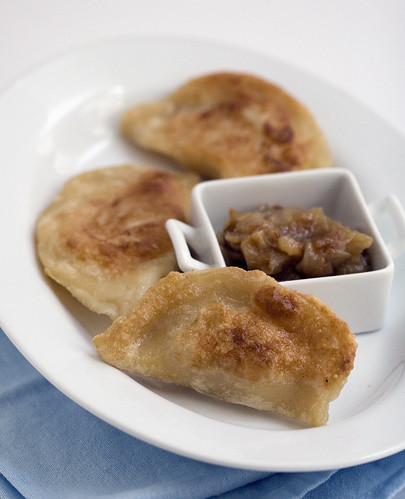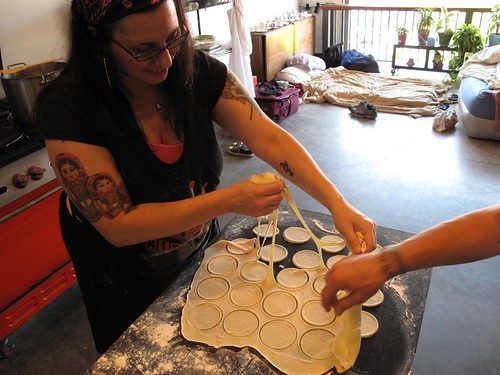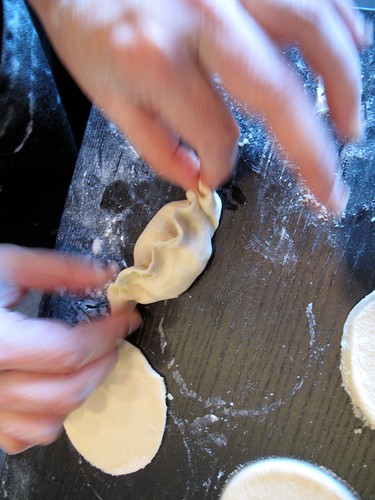Makes around 30 pierogi

This is originally from Vegan Brunch. For some reason I love to make pierogi during Easter. I can’t be alone in that, so I’m publishing this recipe now to give you plenty of planning time.
This is everyone’s favorite Polish dumpling. Toothsome, warm, soft and smothered in caramelized onions – yep, that’s the stuff! In NYC, pierogis are a brunch staple. Polish diners are a disappearing breed, but you can live the life in your own kitchen.
This is one of those time-consuming recipes that will change your life. If you make them once and know what to expect, the next time you make them won’t be such a big deal. Because the ingredients are so simple and unadulterated, choose good quality, organic potatoes whose flavor packs the most punch.
Make filling and dough a night in advance, then all you have to do in the morning is boil pierogis and make the caramelized onions.
For the Caramelized Onions:
1/4 cup canola oil
2 lbs sweet onions (Vidalia or Walla Walla), diced medium
For the Dough:
3 Tablespoons canola oil
1 cup warm water
3 cups all purpose flour (plus a little extra for sprinkling)
3/4 teaspoon salt
Filling:
1 1/2 lbs yukon gold potatoes, peeled and sliced, cut into 3/4 inch chunks
1/4 cup canola oil
1 small onion, finely chopped
1/2 teaspoon pepper
1/2 teaspoons salt
To serve:
Applesauce
To make the caramelized onions:
This is kind of an art, so don’t rush it! Since they onions can be left alone for intervals, start them before starting the dough, then take breaks from kneading the dough to stir the onions. The basic idea here is to sweat the onions, which means you’ll be gently cooking them, covered over low heat, and a lot of the cooking will be done from the steam as the moisture is released. You’re coaxing the sweetness out of them and locking it in. It looks like a lot of onion, and it is, but everything will cook down to manageable proportions, I promise. If you’ve never tasted caramelized onions, you might be surprised that an onion is even capable of this deep, sweet complexity, and with only two ingredients flavor.
Preheat a heavy bottomed skillet, preferably cast iron, skillet over low heat. Add the oil and the onions and toss the onions to coat. Cover and cook for 20 minutes, leaving a little gap for steam to escape. Stir occasionally, every 5 minutes or so. Onions should turn a nice mellow amber, but not burn, although a couple of darker spots are fine.
Remove the cover and turn the heat up just a bit, to a medium setting. Stir often for 10 more minutes. Onions should become a darker amber, and some of the moisture should evaporate.
Make the filling:
In a medium sized pot, cover potatoes in water. Place a lid on the pot and bring to a boil. Once boiling, lower heat to simmer and cook for about 15 more minutes or until potatoes are easily pierced with a fork.
Meanwhile, in a large pan, sautée the onions in oil over medium heat for about 7 minutes. Turn the heat off but stir occasionally even when the heat is turned off because they could still burn from the hot pan. When the potatoes are done boiling, drain them well and add them to the pan with the onions. Just mashed them right in there with a potato masher, that way you are sure to get all the flavor. Add the salt and pepper. Make sure potatoes are mashed well and fluffy. Set aside to cool a bit.
To make the dough:
If you’re like me, you have limited counter space and so rolling out dough can be a hassle. I make the dough last because the mess becomes much more manageable when you don’t have to prep on the counter afterwards. It also gives your filling some time to cool. So make sure you clean up after your filling making and get someone to do the dishes for you. I find that a serene counter makes all the difference in dough making.
Pour the water and oil into a large bowl. Add 2 cups of flour and the salt, keeping one cup aside. Use a fork to stir the flour in, and as it starts to come together, use your hands to knead until a loose dough forms (about 3 minutes.)
Sprinkle your counter with flour, then turn the dough out onto it and knead. Add the reserved cup of flour a little bit at a time, working it into the dough, until it is very smooth and elastic, about 10 minutes. If it’s too sticky, you can add a little bit more flour and knead it in, sometimes up to 1/4 cup extra. Conversely, if you get a good- feeling, smooth, elastic dough that isn’t tacky with less less than the extra cup of flour, then that’s okay, too.
Now we roll the dough out, and also bring a salted pot of water to boil—, the largest pot you’ve got—, for boiling the pierogis.
Divide the dough in half and make sure your counter is clean and sprinkled with a dusting of flour to prevent sticking. Roll half the dough out to about 1/16 of an inch thick, which is to say, very thin but not see through. I rolled it into an 18- by- 10 inch rectangle, but as long as you have the thinness going, the shape doesn’t matter so much. Sprinkle the top with a light dusting of flour.
Now we’re going to make circles. I use the top of a glass that is 3 1/2 inches, but somewhere between 3 1/2 and 4 inches is perfect. Use a glass or a cookie cutter. Have ready a lightly floured plate to place the finished circles on, and go ahead and firmly press your glass or cookie cutter into the dough, as close together as you can. Pull the excess dough up and set aside. Place circles on the floured plate and transfer to the fridge while you repeat with the other half of the dough. Combine the excess doughs and see if you can get a few more wrappers out of the deal.

Pulling up excess dough and having fun
NOTE: If it’s very hot in your kitchen there’s a chance that the circles will stick together. Sprinkle them with flour and make sure they don’t get wet to prevent sticking. If they do stick, you can roll them out and try again.
Now we’re ready to boil some pierogi! Make sure your water is rapidly boiling. The filling should be room temp or colder. Have a small bowl of water for wetting the edges of the wrappers. Place about a tablespoon of filling into the center of a circle and dab water around the circumference of the circle. Fold the edges of the wrapper over filling and pinch in the middle to hold together. Pinch down the sides so that you have a sealed half moon. Don’t be shy with the pinching, and don’t try to make it look like perfect pinches. The most important thing is that you are getting them sealed, so use pressure and really seal them up. I think it looks really cool when the pinches aren’t perfectly spaced, it gives them a beautiful homemade rustic look and let’s you know that it came from a person, not a robot.

Pinching pierogi
If some of the filling is sneaking its way out, then use a little less filling with the next one. Once you get the amount of dough down, you can do a few at a time in assembly line style. I usually do six, lay out the circles, add the filling, pinch them closed. This works out perfectly if you time it with the boiling.
To boil, gently lower pierogis in to the water with a slotted spoon. Boil about six at a time. When they float they are ready. If for some reason they aren’t floating, it takes about 4 minutes for them to cook. Use a slotted spoon to transfer them to a plate as you prepare the rest. Cover finished ones lightly with tin foil to keep warm. Proceed until all pierogi are boiled.
If you’d like to fry instead: Preheat a heavy bottomed skillet over medium high heat, add a thin layer of canola oil, and fry pierogi on each side until golden brown (probably 3 minutes on one side and a minute on the next.) I personally prefer them boiled.
I really like to serve the pierogi in an oversized bowl, sprinkle amply with salt and smother in lots and lots of caramelized onions.

[…] hand at making my own. The results were terrific, and if you’re ever looking for a project, the potato pierogi from Vegan Brunch are […]